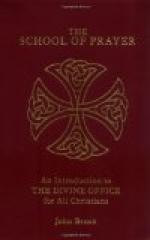The great antiphons are the antiphons of the Magnificat which begin on the 17th December. They are sometimes called the great O’s, or the O antiphons, as each begins with this letter. They begin “O Sapientia, quae ex ore Altissimi prodiisti ...” and continue “O Adonai, O radix Jesse,” etc.... They are the most beautiful antiphons in the liturgy, expressing the prayers and ardent hopes for the coming Saviour. They have formed the subjects of study for poets, scholars and liturgists, ancient and modern. It is asked why these antiphons introduce the Magnificat and not the Benedictus. And liturgists reply: Because the Incarnation was of Mary, and hence these heralds of the Infant King more appropriately introduce Mary’s canticle rather than that of Zachary. And the old liturgists add that these antiphons are said at Vespers, the evening Hour, because the Messias was expected and watched for in the world’s evening. They tell us, too, why there are seven great antiphons. They are to excite our piety during this octave preparatory to the birthday of Christ. This number seven typifies the seven gifts of the Holy Ghost; it represents the seven miseries of mankind, ignorance, eternal punishment, the slavery of the devil, sin, gloom and exile from our fatherland, which is Heaven. And those wonderful men of mediaeval days tell us why we have need of a Teacher, O Sapientia; of a Redeemer, O Adonai; of a Liberator, O Radix Jesse; of a Guardian, O Clavis David; of a brilliant Instructor, O Oriens; of a Saviour to bring us, Gentiles, back to our Great Father, God; O Rex gentium; a Herald to the Jews. Honorius of Autun tells that these antiphons refer to the seven gifts of the Holy Ghost and are arranged in the well-known order in which these gifts are always arranged in works of piety. He says that Christ came in the Spirit of Wisdom, O Sapientia, that in the word “Adonai” is indicated that Christ redeemed us in the Spirit of Understanding. He says, too, that the antiphon “O Radix” signifies the sign of the cross, and that Christ redeemed us in the Spirit of Counsel. “O Clavis” indicates that Christ opened Heaven and closed Hell in the Spirit of Strength or Fortitude. “O Orient” shows forth Christ enlightening us in the Spirit of Knowledge. “Rex gentiam” points out the holy King who saved men by the Spirit of Piety. “O Emanuel” refers to Christ coming in the Spirit of Fear, but giving us also the Law of Love.
These antiphons have formed the theme of the oldest Christian poem in Europe—Cynewulf’s “Christ,” a work which is the admiration of modern scholars. They were celebrated with great pomp and joy in monastic life, the monks carrying their congruous symbolism into their recitation. For, to the gardener-monk was assigned, the chanting of “O Radix Jesse,” and to the cellarer-monk, the “O clavis David”—typifying their work of root-growing and key keeping. (See The Month, No. 489; The Irish Ecclesiastical Record, December, 1918).




